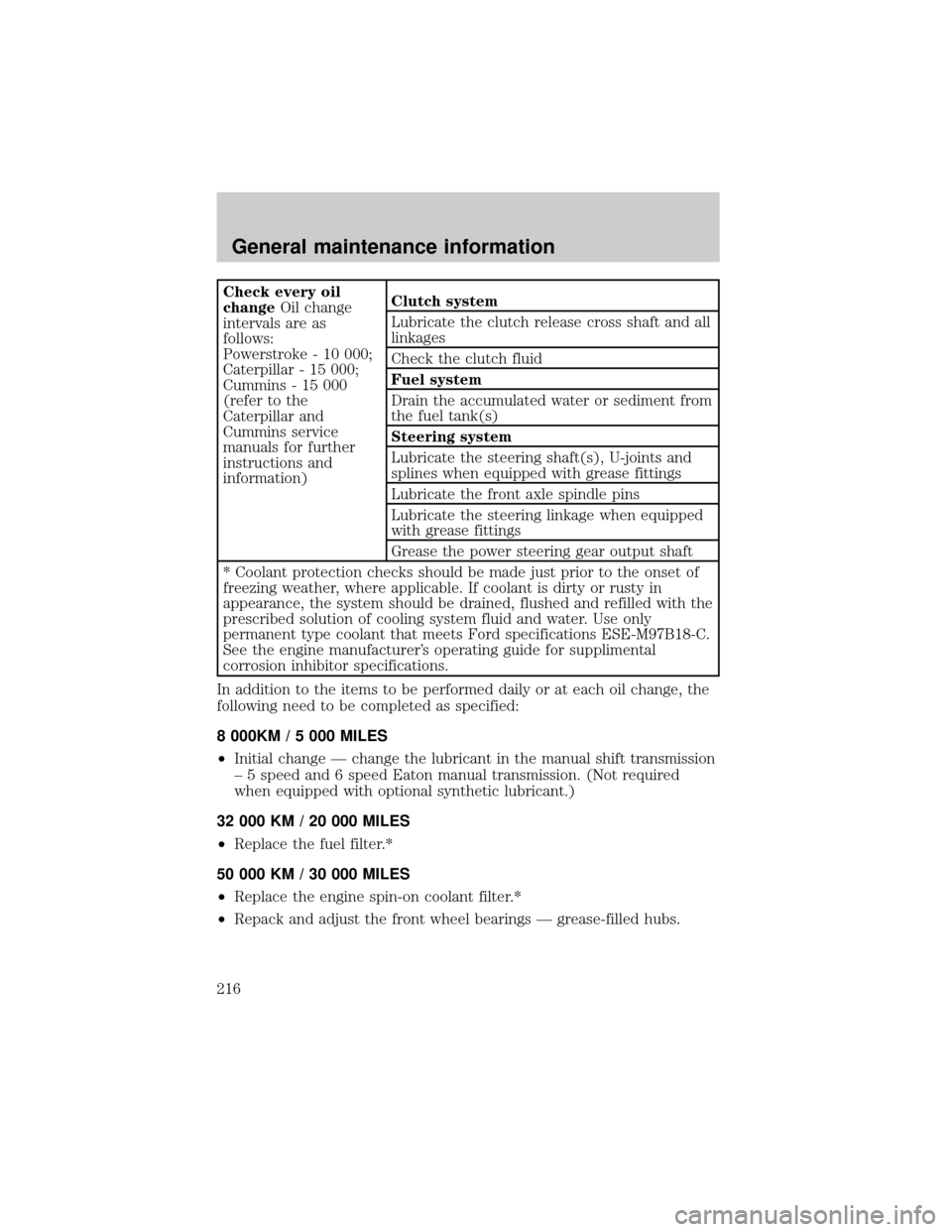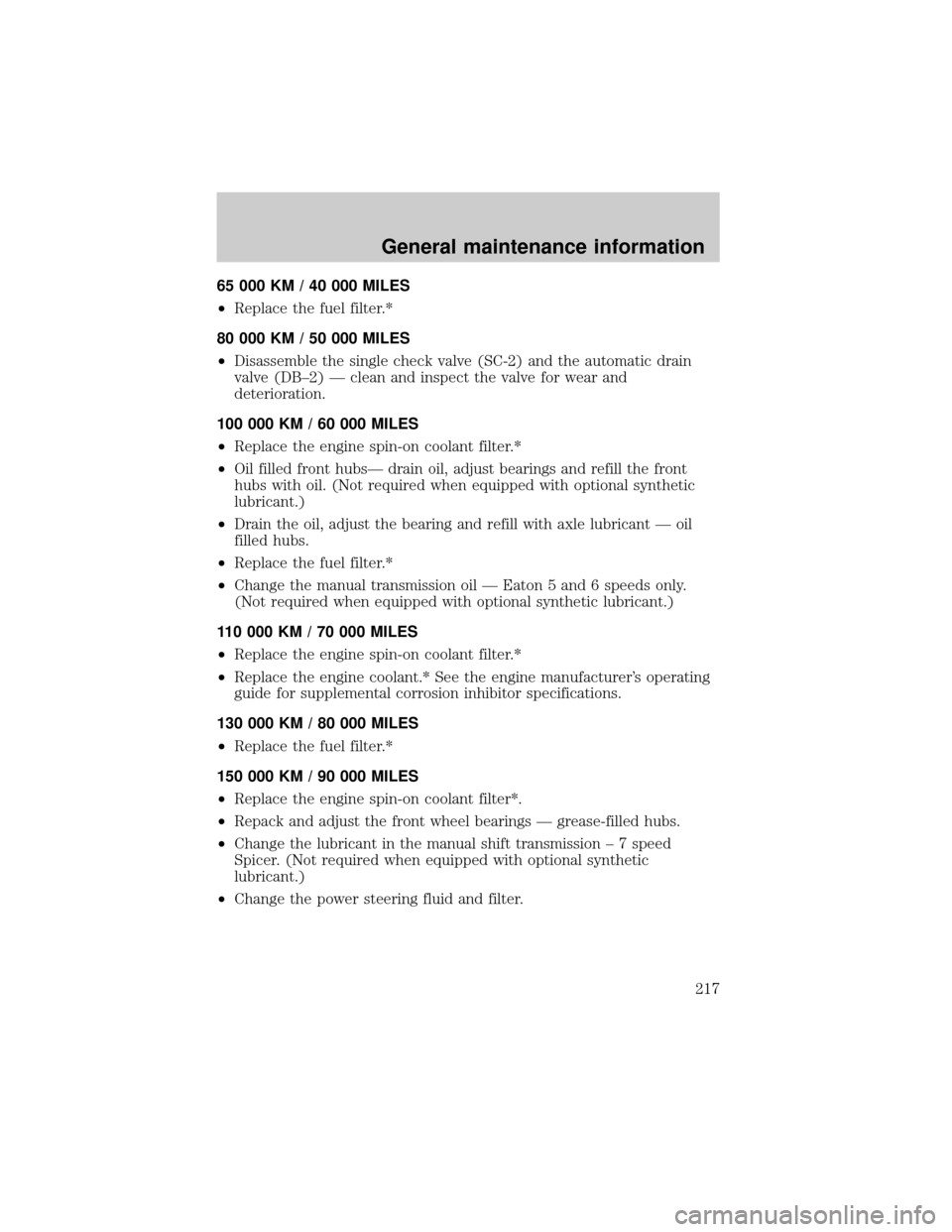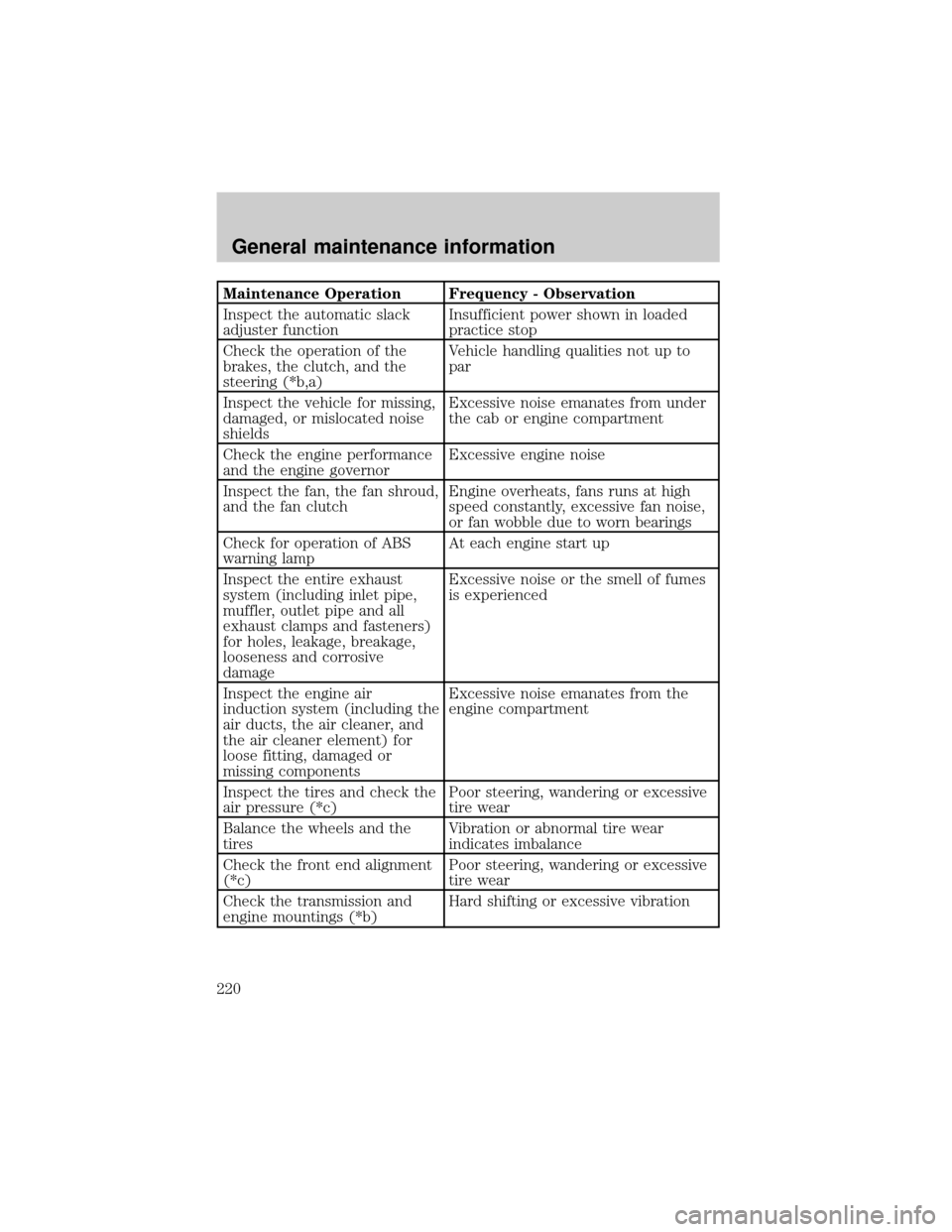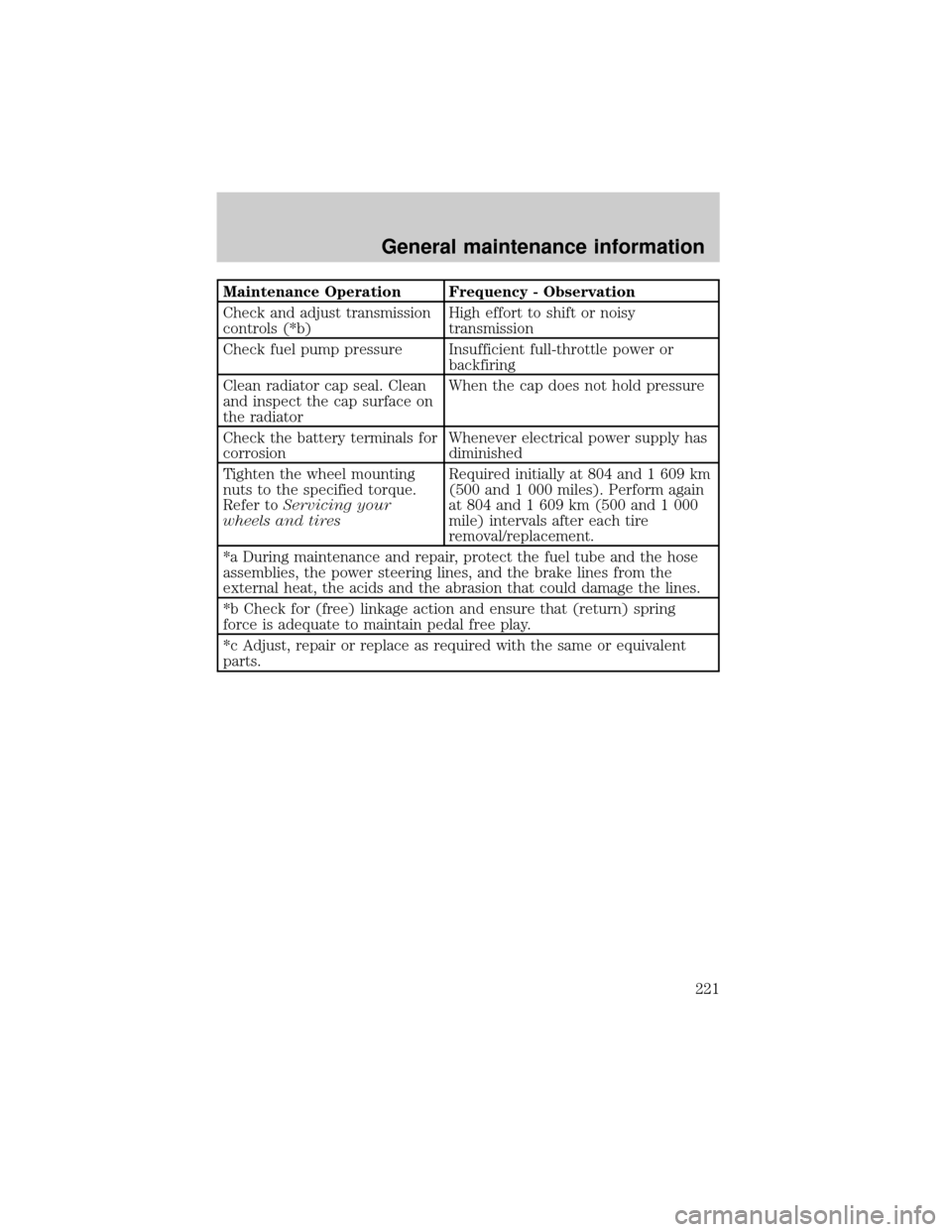Page 214 of 240

Daily Owner Checks Engine system
Check the air filter restriction indicator
Check the engine oil
Inspect the coolant level - for Powerstroke
engine (for Caterpillar and Cummins engines,
refer to the Owner's Manual)
Brake system
Drain the air brake system reservoir - manual
valve
Check the air brake system reservoir
automatic drain valve operation
Transmission system
Visually check the automatic transmission for
fluid leakage
Steering system
Check the power steering pump fluid level and
check the system for leaks
Check the entire vehicle for evidence of fluid
leaks
U.S. Department of Transportation,
Federal Highway Administration
requirements (ensure that the entire
system is functioning properly)
Check the service brakes
Check the parking brake
Check the steering mechanism
Check the lighting devices and reflectors
Check the tires
Check the horn
Check the windshield wipers
Check the rear vision mirrors
Check the wheels and rims
Check the emergency equipment
General maintenance information
214
Page 216 of 240

Check every oil
changeOil change
intervals are as
follows:
Powerstroke - 10 000;
Caterpillar - 15 000;
Cummins - 15 000
(refer to the
Caterpillar and
Cummins service
manuals for further
instructions and
information)Clutch system
Lubricate the clutch release cross shaft and all
linkages
Check the clutch fluid
Fuel system
Drain the accumulated water or sediment from
the fuel tank(s)
Steering system
Lubricate the steering shaft(s), U-joints and
splines when equipped with grease fittings
Lubricate the front axle spindle pins
Lubricate the steering linkage when equipped
with grease fittings
Grease the power steering gear output shaft
* Coolant protection checks should be made just prior to the onset of
freezing weather, where applicable. If coolant is dirty or rusty in
appearance, the system should be drained, flushed and refilled with the
prescribed solution of cooling system fluid and water. Use only
permanent type coolant that meets Ford specifications ESE-M97B18-C.
See the engine manufacturer's operating guide for supplimental
corrosion inhibitor specifications.
In addition to the items to be performed daily or at each oil change, the
following need to be completed as specified:
8 000KM / 5 000 MILES
²Initial change Ð change the lubricant in the manual shift transmission
± 5 speed and 6 speed Eaton manual transmission. (Not required
when equipped with optional synthetic lubricant.)
32 000 KM / 20 000 MILES
²Replace the fuel filter.*
50 000 KM / 30 000 MILES
²Replace the engine spin-on coolant filter.*
²Repack and adjust the front wheel bearings Ð grease-filled hubs.
General maintenance information
216
Page 217 of 240

65 000 KM / 40 000 MILES
²Replace the fuel filter.*
80 000 KM / 50 000 MILES
²Disassemble the single check valve (SC-2) and the automatic drain
valve (DB±2) Ð clean and inspect the valve for wear and
deterioration.
100 000 KM / 60 000 MILES
²Replace the engine spin-on coolant filter.*
²Oil filled front hubsÐ drain oil, adjust bearings and refill the front
hubs with oil. (Not required when equipped with optional synthetic
lubricant.)
²Drain the oil, adjust the bearing and refill with axle lubricant Ð oil
filled hubs.
²Replace the fuel filter.*
²Change the manual transmission oil Ð Eaton 5 and 6 speeds only.
(Not required when equipped with optional synthetic lubricant.)
110 000 KM / 70 000 MILES
²Replace the engine spin-on coolant filter.*
²Replace the engine coolant.* See the engine manufacturer's operating
guide for supplemental corrosion inhibitor specifications.
130 000 KM / 80 000 MILES
²Replace the fuel filter.*
150 000 KM / 90 000 MILES
²Replace the engine spin-on coolant filter*.
²Repack and adjust the front wheel bearings Ð grease-filled hubs.
²Change the lubricant in the manual shift transmission ± 7 speed
Spicer. (Not required when equipped with optional synthetic
lubricant.)
²Change the power steering fluid and filter.
General maintenance information
217
Page 220 of 240

Maintenance Operation Frequency - Observation
Inspect the automatic slack
adjuster functionInsufficient power shown in loaded
practice stop
Check the operation of the
brakes, the clutch, and the
steering (*b,a)Vehicle handling qualities not up to
par
Inspect the vehicle for missing,
damaged, or mislocated noise
shieldsExcessive noise emanates from under
the cab or engine compartment
Check the engine performance
and the engine governorExcessive engine noise
Inspect the fan, the fan shroud,
and the fan clutchEngine overheats, fans runs at high
speed constantly, excessive fan noise,
or fan wobble due to worn bearings
Check for operation of ABS
warning lampAt each engine start up
Inspect the entire exhaust
system (including inlet pipe,
muffler, outlet pipe and all
exhaust clamps and fasteners)
for holes, leakage, breakage,
looseness and corrosive
damageExcessive noise or the smell of fumes
is experienced
Inspect the engine air
induction system (including the
air ducts, the air cleaner, and
the air cleaner element) for
loose fitting, damaged or
missing componentsExcessive noise emanates from the
engine compartment
Inspect the tires and check the
air pressure (*c)Poor steering, wandering or excessive
tire wear
Balance the wheels and the
tiresVibration or abnormal tire wear
indicates imbalance
Check the front end alignment
(*c)Poor steering, wandering or excessive
tire wear
Check the transmission and
engine mountings (*b)Hard shifting or excessive vibration
General maintenance information
220
Page 221 of 240

Maintenance Operation Frequency - Observation
Check and adjust transmission
controls (*b)High effort to shift or noisy
transmission
Check fuel pump pressure Insufficient full-throttle power or
backfiring
Clean radiator cap seal. Clean
and inspect the cap surface on
the radiatorWhen the cap does not hold pressure
Check the battery terminals for
corrosionWhenever electrical power supply has
diminished
Tighten the wheel mounting
nuts to the specified torque.
Refer toServicing your
wheels and tiresRequired initially at 804 and 1 609 km
(500 and 1 000 miles). Perform again
at 804 and 1 609 km (500 and 1 000
mile) intervals after each tire
removal/replacement.
*a During maintenance and repair, protect the fuel tube and the hose
assemblies, the power steering lines, and the brake lines from the
external heat, the acids and the abrasion that could damage the lines.
*b Check for (free) linkage action and ensure that (return) spring
force is adequate to maintain pedal free play.
*c Adjust, repair or replace as required with the same or equivalent
parts.
General maintenance information
221
Page 239 of 240

I
Ignition
removing the key ....................130
Infant seats (see Safety seats) ..97
Instrument panel
cleaning ...................................199
cluster ......................................199
lighting up panel and
interior .......................................21
location of components ............10
J
Jump-starting your vehicle ......157
K
Keys
key in ignition chime ...............16
removing from the ignition ....130
L
Lamps ..........................................74
bulb replacement
specifications chart ................195
cargo lamps ...............................21
daytime running light ...............21
fog lamps ...................................22
headlamps .................................21
headlamps, flash to pass ..........66
instrument panel, dimming .....21
interior lamps ...........................74
replacing bulbs ...............192±194
Lane change indicator (see
Turn signal) .................................65
Lights, warning and indicator ....10
anti-lock brakes (ABS) ....13, 108
brake ....................................10±11charging system ........................11
check coolant ......................14, 16
high beam .................................13
safety belt .................................15
service engine soon ..................15
turn signal indicator .................12
Lubricant specifications ...........201
M
Maintenance and Care ..............211
Manual transmission .................126
Mirrors .........................................77
heated ........................................74
O
Odometer .....................................18
P
Panic alarm feature, remote
entry system ................................79
Parking brake ............110, 113, 116
Power distribution box
(see Fuses) ...............................148
Power door locks ........................76
Power steering ..................124±125
fluid, checking and adding ....168
R
Radio ............................................28
Refill capacities for fluids ........200
Relays ................................143, 152
Remote entry system ...........78±79
illuminated entry ......................79
locking/unlocking doors ...........78
Index
239
Page:
< prev 1-8 9-16 17-24